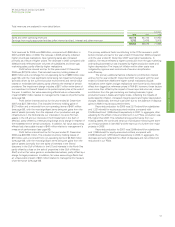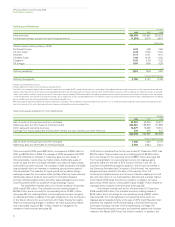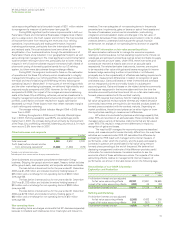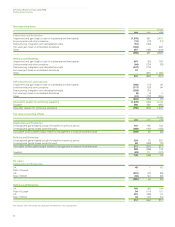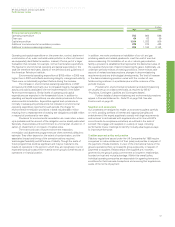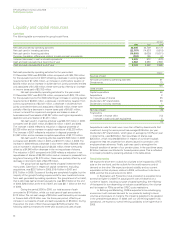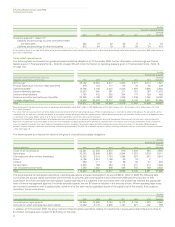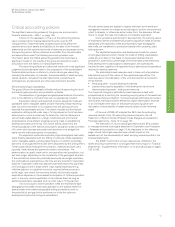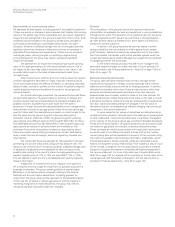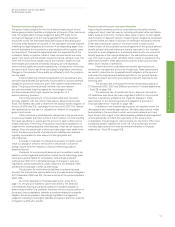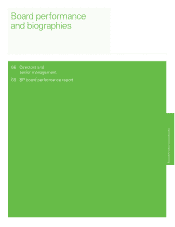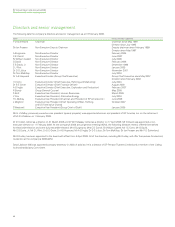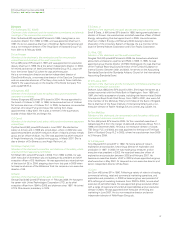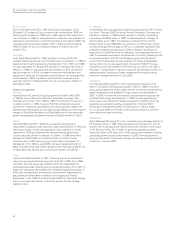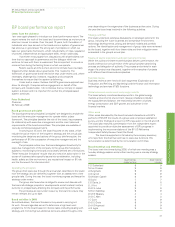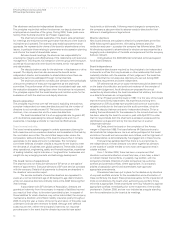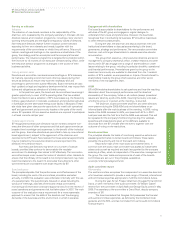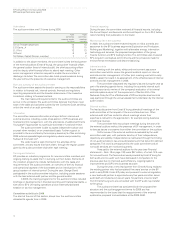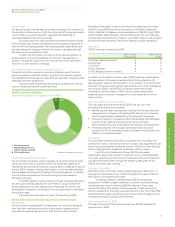BP 2008 Annual Report Download - page 64
Download and view the complete annual report
Please find page 64 of the 2008 BP annual report below. You can navigate through the pages in the report by either clicking on the pages listed below, or by using the keyword search tool below to find specific information within the annual report.
BP Annual Report and Accounts 2008
Performance review
Provisions and contingencies
The group holds provisions for the future decommissioning of oil and
natural gas production facilities and pipelines at the end of their economic
lives. The largest asset removal obligations facing BP relate to the
removal and disposal of oil and natural gas platforms and pipelines
around the world. The estimated discounted costs of dismantling and
removing these facilities are accrued on the installation of those facilities,
reflecting our legal obligations at that time. A corresponding asset of an
amount equivalent to the provision is also created within property, plant
and equipment. This asset is depreciated over the expected life of the
production facility or pipeline. Most of these removal events are many
years in the future and the precise requirements that will have to be met
when the removal event actually occurs are uncertain. Asset removal
technologies and costs are constantly changing, as well as political,
environmental, safety and public expectations. Consequently, the timing
and amounts of future cash flows are subject to significant uncertainty.
Changes in the expected future costs are reflected in both the provision
and the asset.
Decommissioning provisions associated with downstream and
petrochemicals facilities are generally not provided for, as such potential
obligations cannot be measured, given their indeterminate settlement
dates. The group performs periodic reviews of its downstream
and petrochemicals long-lived assets for any changes in facts
and circumstances that might require the recognition of a
decommissioning provision.
The timing and amount of future expenditures are reviewed
annually, together with the interest rate used in discounting the cash
flows. The interest rate used to determine the balance sheet obligation at
the end of 2008 was 2%, unchanged from the end of 2007. The interest
rate represents the real rate (i.e. adjusted for inflation) on long-dated
government bonds.
Other provisions and liabilities are recognized in the period when
it becomes probable that there will be a future outflow of funds resulting
from past operations or events and the amount of cash outflow can be
reliably estimated. The timing of recognition requires the application of
judgement to existing facts and circumstances, which can be subject to
change. Since the actual cash outflows can take place many years in the
future, the carrying amounts of provisions and liabilities are reviewed
regularly and adjusted to take account of changing facts and
circumstances.
A change in estimate of a recognized provision or liability would
result in a charge or credit to net income in the period in which the
change occurs (with the exception of decommissioning costs as
described above).
Provisions for environmental clean-up and remediation costs are
based on current legal and constructive requirements, technology, price
levels and expected plans for remediation. Actual costs and cash
outflows can differ from estimates because of changes in laws and
regulations, public expectations, prices, discovery and analysis of site
conditions and changes in clean-up technology.
The provision for environmental liabilities is reviewed at least
annually. The interest rate used to determine the balance sheet obligation
at 31 December 2008 was 2%, the same rate as at the previous balance
sheet date.
As further described in Financial statements – Note 44 on
page 174, the group is subject to claims and actions. The facts and
circumstances relating to particular cases are evaluated regularly in
determining whether it is ‘probable’ that there will be a future outflow of
funds and, once established, whether a provision relating to a specific
litigation should be adjusted. Accordingly, significant management
judgement relating to contingent liabilities is required, since the outcome
of litigation is difficult to predict.
Pensions and other post-retirement benefits
Accounting for pensions and other post-retirement benefits involves
judgement about uncertain events, including estimated retirement dates,
salary levels at retirement, mortality rates, rates of return on plan assets,
determination of discount rates for measuring plan obligations, healthcare
cost trend rates and rates of utilization of healthcare services by retirees.
These assumptions are based on the environment in each country.
Determination of the projected benefit obligations for the group’s defined
benefit pension and post-retirement plans is important to the recorded
amounts for such obligations on the balance sheet and to the amount of
benefit expense in the income statement. The assumptions used may
vary from year to year, which will affect future results of operations. Any
differences between these assumptions and the actual outcome also
affect future results of operations.
Pension and other post-retirement benefit assumptions are
reviewed by management at the end of each year. These assumptions
are used to determine the projected benefit obligation at the year-end
and hence the surpluses and deficits recorded on the group’s balance
sheet, and pension and other post-retirement benefit expense for the
following year.
The pension and other post-retirement benefit assumptions at
31 December 2008, 2007 and 2006 are provided in Financial statements
– Note 38 on page 159.
The assumed rate of investment return, discount rate and the
US healthcare cost trend rate have a significant effect on the amounts
reported. A sensitivity analysis of the impact of changes in these
assumptions on the benefit expense and obligation is provided in
Financial statements – Note 38 on page 159.
In addition to the financial assumptions, we regularly review the
demographic and mortality assumptions. Mortality assumptions reflect
best practice in the countries in which we provide pensions and have
been chosen with regard to the latest available published tables adjusted
where appropriate to reflect the experience of the group and an
extrapolation of past longevity improvements into the future. BP’s most
substantial pension liabilities are in the UK, US and Germany and the
mortality assumptions for these countries are detailed in Financial
statements – Note 38 on page 159.
Performance review
63


